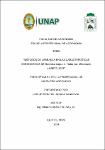Métodos de labranza en las características agronómicas de Brassica napus L. Nabo var. Minowase. Loreto 2023
Abstract
Tillage are activities that, over time, form the ideal soil in order to ideal soil in order to allow the root system to explore the largest volume of soil and to to explore the largest volume of soil and absorb the available nutrients. The objective of this study was to evaluate the effect of tillage types on agronomic tillage types on the agronomic characteristics and yield of Brassica napus L. Nabo var. Minowase. Loreto 2023. The study was conducted at the Faculty of Agronomy-UNAP, Horticultural Plants Workshop. A completely randomized block design was used (DBCA) with 2 treatments (T0: manual tillage and T1: mechanical tillage). and T1: mechanized tillage) with 12 replications. The main conclusions were that the main conclusions were that the agronomic characteristic of plant extension did show significant differences significant differences between soil tillage types., which meant a greater leaf area to capture more solar energy and accumulation of reserves, the root diameter and length characteristics did present significant differences between soil tillage types, but contrary, since the diameter was greater and lesser in length in manual tillage, respectively, and in mechanized tillage the diameter was lesser and greater in length, respectively, the aerial part (leaf weight) was lesser in manual tillage (50. 64 g) than in mechanized tillage (61.67 g), root weight, actual and potential yield showed the highest results with manual tillage (142.2 g, 24,923 kg ha-1 and 35,604 kg ha-1), mechanized tillage is not always synonymous with crop yield. La labranza son actividades que mediante el tiempo forman el suelo ideal con la finalidad de permitir que el sistema radicular explore el mayor volumen de suelo y absorber los nutrientes disponibles. El objetivo de este estudio fue evaluar el efecto de los tipos de labranza sobre las características agronómicas y el rendimiento de Brassica napus L. Nabo var. Minowase. Loreto 2023. El estudio fue realizado en la Facultad de Agronomía-UNAP, Taller de Plantas Hortícolas. Fue utilizado un diseño de bloques completamente al azar (DBCA) con 2 tratamientos (T0: labranza manual y T1: labranza mecanizada) con 12 repeticiones. Las principales conclusiones fueron que las característica agronómica de extensión de planta si presentó diferencias significativas entre los tipos de labranza del suelo, lo que significó una mayor área foliar para captar mayor energía solar y acumulación de reservas, las características diámetro y longitud de raíz si presentaron diferencias significativas entre los tipos de labranza del suelo, pero contrarias, ya que el diámetro fue mayor y menor en longitud en la labranza manual, respectivamente, y en la labranza mecanizada el diámetro fue menor y mayor en longitud, respectivamente, la parte aérea (peso de hojas) fue menor en la labranza manual (50.64 g) que en la mecanizada (61.67 g), el peso de raíz, rendimiento real y potencial presentaron los mayores resultados con la labranza manual (142.2 g, 24,923 kg ha-1 y 35,604 kg ha-1), la labranza mecanizada no siempre es sinónimo de rendimiento en el cultivo.
Collections
- Tesis [670]


